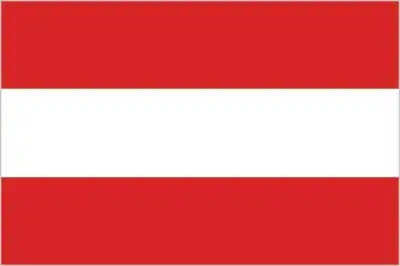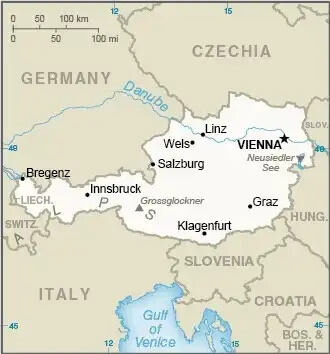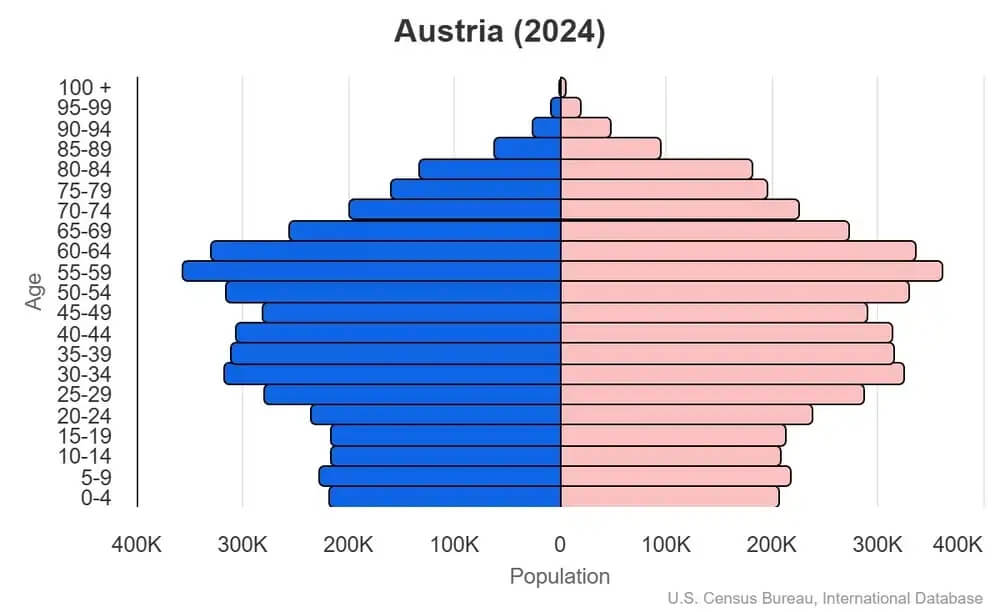World Book
Austria
World Book Index
81


With a score of 81, the country is ranked 12th out of 158 countries in the World Book ranking. (more information)
Introduction
Background
Once the center of power for the large Austro-Hungarian Empire, Austria was reduced to a small republic after its defeat in World War I. A State Treaty signed in 1955 recognized Austria's independence after a decade of Allied occupation. The treaty's neutrality requirement has kept Austria from joining NATO, but the country joined the EU in 1995.
Geography
Area
total : 83,871 sq km
land: 82,445 sq km
water: 1,426 sq km
Climate
temperate; continental, cloudy; cold winters with frequent rain and some snow in lowlands and snow in mountains; moderate summers with occasional showers
Natural resources
oil, coal, lignite, timber, iron ore, copper, zinc, antimony, magnesite, tungsten, graphite, salt, hydropower
People and Society
Population
total: 8,967,982 (2024 est.)
Ethnic groups
Austrian 80.8%, German 2.6%, Bosnian and Herzegovinian 1.9%, Turkish 1.8%, Serbian 1.6%, Romanian 1.3%, other 10% (2018 est.)
Languages
German (official nationwide) 88.6%, Turkish 2.3%, Serbian 2.2%, Croatian (official in Burgenland) 1.6%, other (includes Slovene, official in southern Carinthia, and Hungarian, official in Burgenland) 5.3% (2001 est.)
Religions
Roman Catholic 55.2%, Muslim 8.3%, Orthodox 4.9%, Evangelical Christian 3.8%, Jewish 0.1%, other 5.4%, none 22.4% (2021 est.)
Population growth rate
0.3% (2024 est.)
Government
Government type
federal parliamentary republic
Capital
name: Vienna
Executive branch
chief of state: President Alexander VAN DER BELLEN (since 26 January 2017)
head of government: Chancellor Christian STOCKER (since 3 March 2025)
Diplomatic representation in the US
chief of mission: Ambassador Petra SCHNEEBAUER (since 19 APRIL 2023)
Diplomatic representation from the US
chief of mission: Ambassador (vacant); Chargé d'Affaires Kami A. WITMER (since 20 January 2025)
Economy
Economic overview
one of the strongest EU and euro economies; diversified trade portfolios and relations; enormous trade economy; Russian energy dependence, but investing in alternative energy; aging labor force but large refugee population; large government debt
Real GDP (purchasing power parity)
$581.131 billion (2024 est.)
$588.031 billion (2023 est.)
$593.701 billion (2022 est.)
Real GDP per capita
$63,300 (2024 est.)
$64,400 (2023 est.)
$65,700 (2022 est.)
Exports
$299.366 billion (2024 est.)
$303.914 billion (2023 est.)
$291.804 billion (2022 est.)
Exports - partners
Germany 25%, USA 9%, Italy 7%, Switzerland 5%, Hungary 4% (2023)
Exports - commodities
cars, packaged medicine, vaccines, vehicle parts/accessories, nitrogen compounds (2023)
Imports
$284.467 billion (2024 est.)
$293.692 billion (2023 est.)
$294.324 billion (2022 est.)
Imports - partners
Germany 34%, China 7%, Italy 7%, Switzerland 5%, Czechia 4% (2023)
Imports - commodities
cars, garments, vaccines, vehicle parts/accessories, refined petroleum (2023)
Human Development Index
The country's Human Development Index (HDI) is 0.930, ranking it 22nd out of 193 countries tested. (more information)
World Happiness Report
The World Happiness Report ranked the country 12th out of 158 countries tested with a score of 7.029. (more information)



